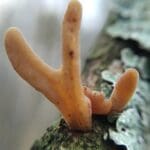Pipe club / Autumn / Inedible
Scientific Name
Typhula fistulosa, synonyms Clavaria fistulosa
Common Names
Pipe club
Family
Typhulaceae
A type of Clavaroid fungi, which is one of the most basic forms of fungi fruit body and has arisen numerous times through fungi evolution.
Habitat
Saprophytic, growing in broad-leaf woodlands and woodland edges, particularly with birch. Sometimes growing off dead wood but more commonly seen growing off leaf litter. Can be easily overlooked being mistaken for twigs or stems.
Description
Very peculiar fungi, resembling worms suspended out the ground, Uncommon in Britain and Ireland, but can be seen from June to November.
Identifying Features
Fruit body
Colour- Mainly ochra with light to mid brown at the base and dark still where it attaches with root like structures. Sometimes more orange tones towards the tip.
Shape- An unbranching tubular shape, becoming slightly wider towards the tip, often flattened on one side sometimes with a twist. Soft longitudinal grooves. Growing upwards either straight or more often with a wave between 5-30cm tall and 5-10mm wide. Typically fruits in multiples.
Pores/gills
The spores are released from the smooth surface of the tips on the fruit body. No visible pore or gills
Smell
No distinctive
Spores
White
Uses
There are no recorded uses for this fungi.
Known hazards
None known
Potential lookalikes
Other types of non branching club fungi such as Golden Spindles (Clavulinopsis fusiformis) but this grows in denser clumps and is yellow in colour.
Extra Notes
The generic name Typhula comes from Latin and means slightly smokey. Much more obvious, and again from Latin, is the specific epithet fistulosa, which simply means shaped like a pipe or a tube.
References:
https://www.first-nature.com/fungi/typhula-fistulosa.php
Fungi of temperate europe vol 2 by Thomas Laessoe and Jens H Peterson








